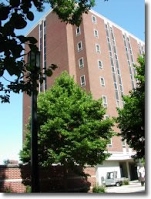Further details will be posted here as they become available. Or you may
contact the University of Illinois organizers
.
Bruce Reznick (UIUC) 11:00h-12:00h
Title: Steampunk canonical forms
Abstract: What is steampunk? It is a style based on combining 19th century
Victorian culture with bits of modern life, such as computers. What are
steampunk canonical forms? 19th century algebra plus the concept of vector
spaces plus Mathematica plus the hope that there is juice left in the
algebraic geometry of binary forms. One example: a general binary sextic
form can be written as the sum of a quadratic form cubed and a cubic form
squared. Numerical experiments suggest this can be done in 40 ways.
Claudia Polini (Notre Dame) 2:00h-3:00h
Title: Studies on curve singularities
Abstract: The goal of the talk is to relate the singularity types of a rational plane
curve to the syzygies of the forms parametrizing it. This is a report on
joint work with Cox, Kustin, and Ulrich.
More specifically, let C be a rational plane curve of degree d parametrized
by three forms, which can be assumed to be of degree d as well. The syzygy
matrix of this parametrization is a 2 by 3 matrix whose entries are forms
of degrees d_1 and d_2, where d_1 + d_2=d. Among other things we consider
curves of even degree d=2c; we show that if C has a singular point
(including an infinitely near singular
point) of multiplicity at least c, then the multiplicity of this singularity
is exactly c and furthermore d_1 = d_2 =c. We establish, essentially, a
correspondence between the constellation of multiplicity c singularities on
or infinitely near C on the one hand and the shapes of the syzygy matrices
on the other hand. Using this, we give a stratification of the space of
rational plane curves into irreducible locally closed sets, according to the
constellation of singularities of maximal multiplicity c.
Wenbo Niu (Purdue) 3:30h-4:30h
Title: Asymptotic Regularity of Ideal Sheaves
Abstract: Let $\sI$ be an ideal sheaf on $\nP^n$ . Associated to $\sI$ there are three elementary
invariants: the invariant $s$ which measures the positivity of $\sI$, the minimal number $d$
such that $\sI(d)$ is generated by its global sections, and the Castelnuovo-Mumford
regularity $\reg\sI$. In general one has $s\leq d\leq \reg\sI$. If we consider the asymptotic
behavior of the regularity of $\sI$, that is the regularity of $\sI^p$ when $p$ is
sufficiently large, then we could have a clear picture involving these invariants. We will
talk about two main theorems in this direction. The first one is the asymptotic regularity
of $\sI$ is bounded by linear functions as $sp\leq \reg \sI^p\leq sp+e$, where $e$ is a
constant. The second one is that if $s=d$, i.e., $s$ reaches its maximal value, then for $p$
large enough $\reg \sI^p=dp+e$ for some positive constant $e$.
-------------------------------------------------------------------------------------------------------------------------------------
Parking: Please, park anywhere at the parking lot next to the IT building
(except for meters).
We will distribute the daily parking permits free of charge, which have to
be put on display in each car promptly.
Lodging: We put on hold a block of guestroom at University Place, see
http://www.iupui.edu/building/HO.htm
at the rate of $99 per night plus tax. Make reservations by calling
1-800-627-2700 (select Option #1)
or 317-231-5160. Please, identify your group affiliation: Algecom conference
to get the discounted rates.
The reservations have to be made by 5:00pm to September 29, 2011.
Banquet: An all you can eat 8 China buffet, see
http://www.8chinabuffet.com/
The approximate cost is $12 (alcohol extra).


